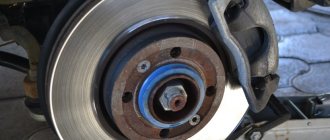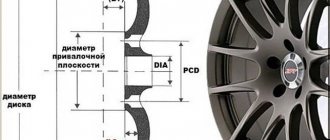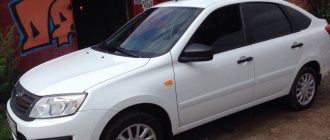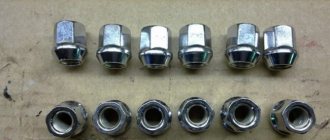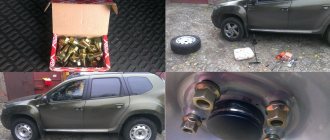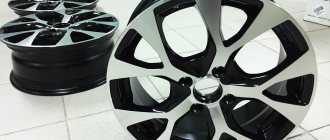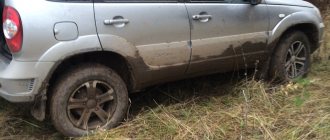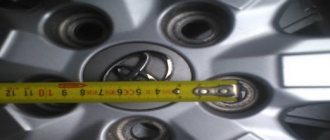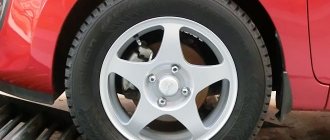Every driver should know that the size of tires and wheels is one of the main factors that significantly affects the behavior of the car on the road. Each manufacturer indicates the acceptable sizes of tires and wheels; this list consists of several options. Do you know what other tires and wheels are suitable for Vesta besides those specified by the manufacturer?
Original tires
As you know, any wheel includes a tire and a rim. Moreover, they can be of different sizes. sets the following standard size for the wheels of his new car (we mean the simplest configuration): 185/65, and this is with a radius of 15. The indices of other indicators are equal to 88H or 88T.
All these tricky numbers reflect the following parameters:
- Width, mm: 185.
- Profile: 65 percent of the width ((185/100)*65).
- Discs, radius: 15'.
- 88: maximum weight 560 kilograms.
- H: speed index (less than or equal to 210 km/h). In the case of T instead of H: less than or equal to 190 km/h.
The manufacturer of such wheels is the Belshina enterprise, and the wheels themselves are called ArtMotion. The product is characterized by sufficiently soft rubber, which has good endurance along with excellent road grip and low noise levels. The option for the cold season is called ArtMiton Snow.
On the most inexpensive Vesta trim levels, the tires are mounted on stamped steel. The dimensions of these disks are: 6J15ET504x10060.1. As an option, light alloys with the same parameters can be installed. Such discs are produced by K&K, and the disc model is called ANNA-15.
The above dimension is deciphered as follows:
- 6J: rim width (here 6').
- 15: installation diameter (here 15').
- ET50: offset (here 50 mm).
- 4x100 (diameter of the circle of the centers of the mounting holes or PCD). Installation is carried out using 4 bolts located on a circle measuring 100 mm. Sometimes this parameter is called bolt pattern.
- 1: disc hub mounting diameter (DIA).
The manufacturer equips the richest configurations of the Lada Vesta with the following standard sizes: 195/55R1691H or 195/55R1691T .
Let's decipher these numbers:
- Width, mm: 195.
- Profile height: 107.25 mm, which is 55% of 195.
- R16: rim width in (here 16').
- 91: load capacity indicator (for number 91 this is 615 kg).
- H: speed indicator (less than or equal to 210 km/h, in the case of T: less than or equal to 190 km/h).
Such tires for the auto giant are produced by the German company Continental. The model is called EcoContact. However, alloy wheels are no longer manufactured by Continental, but by K&K (the wheel model is called Ptalomey 16). The discs have dimensions 6Jx16ET504x10060.1. In fact, they differ only in the fit size, which is 16 inches.
However, similar wheels and the same rims can be installed on the most inexpensive Lada Vesta configurations - however, as an optional feature.
A car in the Luxe version, for some money, can also be equipped with wheels (with 17 discs) of a similar model from the same manufacturer: Ptalomey 17. Below in the table you can see the wheel sizes for Lada Vesta:
How was it before at AvtoVAZ?
Previously, the standard for passenger car tires at AvtoVAZ was within the range of 13–14 inches, rarely going beyond this range.
Wheels are 17 radius.
With the advent of Vesta, a lot has changed. At first we were talking about the fifteenth size, and after some time, the wheel size parameters reached the designations R16 and even R17. Most of all at the start there were attempts to change the car into 15-inch “shoes”, but AvtoVAZ quickly saw the future prospect.
Additional sizes
Many car enthusiasts install wheels and tires of a different size on their car, for various reasons: it could be repairs after an accident or just a modification. Let's try to understand in more detail the adequate mounting options for non-standard tires and wheels on the Lada Vesta. We will also consider the advantages and disadvantages of this operation, as well as the consequences of possible installations that promise serious losses in the operating parameters of individual components and assemblies (including early breakdowns).
If the car owner simply decided to change the tires on his car (without changing the dimensions), there is nothing wrong with that. But in this case, it is necessary to ensure that all tires contain the same tread, as well as an equal degree of wear (in this case, the tread is allowed to differ only for the front and rear axles).
Fuel consumption
The new Lada Vesta is equipped with a 1.6 liter engine of two types: 1st - with 8 valves, 2nd - with 16 valves.
The 8-valve engine has the lowest performance: its peak power is 87 hp, and its torque is 140 Hm. The engine is equipped with a 5-speed gearbox and consumes no more than 7.5 liters per 100 km.
The engine with 16 valves was manufactured at AvtoVAZ. Its power is 106 hp. The engine provides for the installation of both robotic and manual gearboxes. With a robotic gearbox, the engine consumes about 7 liters. per 100 km. This is exactly the engine installed on the Lada Vesta models that were the first to go on sale.
The third type of engine has the highest performance. It was developed jointly by Renault-Nissan, its power is 114 hp. Fuel consumption on such an engine will be 6.9 liters. per 100 l.
Wheels from other Ladas will not fit
Cars with standard size 185/55 radius 15 (remember that these are products from Grant and Priora) are not the same size as Vesta, although offhand they look the same. The fact is that the landing hub diameter of the above car models is 1.6 mm smaller (it is 58.5 mm).
If you try to correct this hole to the required size using a turning groove, in any case, the PCD indicator for such disks will not be 4x100, but 4x98, as a result you will get three fastening bolts that do not coincide with the fastening holes at all. As a result, the alignment of the disk and the hub will be disrupted, and the movement of the vehicle will be accompanied by beating.
Oversized wheels
Wheels of abnormal size not only change the appearance of the car, but also have a significant impact on both the dynamics and stability of cars on the highways. And, perhaps, the only improvement in the use of large-sized wheels is an increase in cross-country ability by increasing the ground clearance of the same West SV.
It is possible (and the factory does not prohibit this) to equip the Lada Vesta with 18-inch wheels.
But negative consequences in the form of increased wear, as well as the possibility of early failure due to the national characteristics of Russian municipal roads, may forever discourage such tuning experiments. Moreover, if you consider that large-sized slopes are much more expensive than standard tires.
Oversized wheels
Such discs don’t just change the appearance of the car; dynamic performance, handling, and driving stabilization also depend on them. Often, all this data changes for the worse when replacing larger disks.
If you are interested in such a setup, always remember that enlarging the rim will certainly mean choosing other tires (necessarily with a smaller profile). The fact is that the outer diameter of the tire in any case cannot be larger than that recommended by the manufacturer (don’t forget about the wheel arches), otherwise the tires will scratch along the arches when driving (especially when cornering), and this, as you know, is not at all good.
During 12-month tests, the following standard sizes were successfully installed on the Lada Vesta car:
- Radius 15 – 175/70 and 205/60.
- Radius 16 – 185/60.
- Radius 17 – 175/55 and 195/50.
Note that 17' diameter wheels were installed on test modifications of Vesta. In principle, 18-inch wheels can be mounted on a car, but the outer diameter of this tire is almost 670 mm and the width is 235 mm. These parameters are very different from those recommended by the factory, and, despite the formal possibility of installation, real domestic roads will not allow such tires to drive normally (low-profile tires) - road irregularities will quickly ruin the wheels - note, at their price, several times higher than the original ones.
Advantages of mounting large drives:
- Visual effect, the car seems to become more fashionable.
- Increased dynamic properties, road stability, and steering system feedback.
- Less response from road potholes.
- Thrifty attitude towards suspension life (with a profile of at least 55%).
- Reducing the distance when braking.
- Improved functioning of ESP, ABS systems.
- Reducing braking length;
Disadvantages of mounting large drives:
- Lack of convenience when moving (large transfer of road damage to the interior and steering wheel).
- Undesirable driving on bad roads.
- Increased control over tire pressure.
- Increased fuel consumption due to the need for increased energy consumption when starting off.
- High price.
Choosing tires for different operating conditions
Winter becomes a real headache for car enthusiasts; some prefer not to use their cars during this period, while others have to buy winter tires. You cannot drive on summer tires in the cold season - their composition is not designed for low temperatures. Braking, starting to move, and driving become impossible.
Choosing winter tires
Large tires can be installed on Vesta, but for winter it is better to install smaller wheels. If R16 is used in summer, then R15 is recommended for winter. The tire width is also selected smaller. In winter, speed characteristics are not so important. Studded tires and so-called “Velcro” tires are available on the market. It is ideal for residents of large cities who rarely go off-road. Spikes are not needed on asphalt roads. For those who often travel on snowy, icy roads, they are definitely necessary.
Tread pattern selection
There are three types of drawing:
Tire tread pattern
- Symmetric. Both sides of the pattern are the same and have a wave or bridge shape. Equally effective on snow and ice. Loses its properties on snow porridge in the spring or after treatment with reagents.
- Directed. It is not afraid of snow, ice, and also does not lose its properties in slush. Not suitable for use on dry asphalt due to increased noise. The peculiarity of these tires is in the direction - they must be mounted strictly according to the direction of travel arrow, which is indicated on the outer side of the product with the inscription “Rotation”.
- Asymmetrical. In addition to all the advantages of the described figures, noise reduction and high speed characteristics are added. It is installed according to marks indicating the inside and outside with inscriptions on the sides - “Inside”/“Outside”. The only drawback is the high price.
To save money, you can use the directional option. If your budget allows, it is better to choose an asymmetrical pattern.
Selection by stud size
A regular thorn looks like a nail - this is the most common type. There are also other shapes - square, rectangle. At the same time, at speeds up to 60 km/h, the braking distance does not change in any way, and there is no point in paying more, because in winter it is unsafe to increase the speed. From popular brands you can choose the following:
- Nokian Hakkapeliitta 8 – is in the middle price range, the estimated cost is from 4 to 5 thousand rubles;
- Bridgestone Blizzak Spike-01 – from 3 thousand rubles;
- Yokohama Ice Guard F700Z – average price – 2 thousand rubles;
- Dunlop Ice Touch – average price – 2.7 thousand rubles;
- Michelin X-Ice North 3 – 3-3.5 thousand rubles;
- “Kama Euro” 519 and “Belshina” Bel-127 - up to 2 thousand rubles.
The choice is large, for high quality and brand you will have to pay a substantial amount. If your budget is limited, you can purchase domestically produced winter tires. They are cheaper, but this does not mean that their quality and efficiency are worse.
Choosing summer tires
Summer tires for cars are made from hard compounds, which is determined by temperature and speed operating conditions. These tires wear out more slowly and do not lose grip on hot asphalt. These wheels have a different tread pattern and depth from winter ones.
Tire size
Choose a size that matches the manufacturer's requirements. It is possible to use alternative options, but in this regard different points should be taken into account:
- If the outer diameter of the wheel turns out to be larger than the manufacturer allows, it will cling to the arch when driving over uneven surfaces and when turning.
- When installing tires with a large width, there will also be friction along the arches, which is unsafe and leads to rapid wear of the rubber.
- Installing tires with a low profile will make the suspension too stiff, which will lead to failure of the chassis components. But low-profile tires increase steering sensitivity, allowing you to better control the car when driving at high speeds. This is not the best option for driving on domestic roads.
- An excessively high profile reduces control efficiency; at high speed, there is a high risk of losing the tire from the rim, which will lead to an accident. Properly selected high-profile tires improve the smoothness of movement, easily absorb all potholes and bumps, and are able to preserve the life of the suspension.
Summer tires on the Lada Vesta should be wider (within reasonable limits), this increases the contact patch with the road surface and improves dynamic characteristics. But this will lead to increased fuel consumption and the risk of aquaplaning even at low speeds when driving through puddles. Based on this, we can conclude that when choosing the type of tires, many factors need to be taken into account. In most cases, it is advisable to stick to the size recommended by the manufacturer. For the average car driver in city mode, this is enough.
Tread selection
According to the type of pattern, there are symmetrical, asymmetrical and directional protectors. An inexpensive option is a standard tire with a non-directional pattern. It has average characteristics of controllability, comfort and aquaplaning prevention. In terms of price-quality ratio, it will be the best option for leisurely trips. If necessary, the tires can be placed on different sides.
Rubber with a directional pattern has better handling, comfort and prevents aquaplaning. One of the advantages of this pattern is the quick removal of water from the tread. They are installed in accordance with the direction of travel, so they cannot be mounted differently when rearranging the wheels between the right and left sides. Otherwise, control safety is sharply reduced.
Rubber with an asymmetric tread pattern is a universal option with equally good handling and comfort on various road surfaces. The outer part consists of larger and more rigid blocks, which improve cornering control. The tread pattern on the inside consists of smaller blocks and drains water more efficiently, increasing traction on wet asphalt. To ensure directional stability, there is a longitudinal stiffener rib in the middle. Such wheels can be moved from one side to the other. The only drawback is the high price compared to directional and non-directional tires.
Popular brands of summer tires for Lada Vesta include:
- TRIANGLE GROUP TR928 – cost does not exceed 2.5 thousand rubles;
- NOKIAN NORDMAN SX2 – from 3 thousand rubles;
- MICHELIN ENERGY XM2 – from 3.5 thousand rubles;
- YOKOHAMA GEOLANDAR SUV G055 – from 7 thousand rubles;
- HANKOOK VENTUS V12 EVO2 K12 – from 8 thousand rubles.
The most affordable option is Kama Euro and Belshina tires, the cost of which usually does not exceed 2 thousand rubles per tire.
Selection of all-season tires
The constant rise in prices for cars and related products forces car owners to look for ways to save money. One of its options is to buy universal tires. This type of tire is only suitable for countries where the climate is mild all year round. “All-season” vehicles are not suitable for the harsh winter months of the middle zone. When the temperature drops to 7 degrees, the elasticity of rubber with the “allseasons” index decreases, the braking distance increases and the risk of losing control increases. An all-season tire is a middle option between summer and winter, so you shouldn’t expect high performance from it.
“All-season tires” have a less frequent tread pattern compared to winter tires and are of medium softness. The side part has rounded shapes, dissected sipes, and a tread with deep recesses. For summer they show good grip qualities, but for snow and ice they are useless. You can identify such tires by the inscription “All Seasons”. It has no practical meaning - driving is allowed at temperatures not lower than -5 degrees. At lower temperatures the tire becomes too hard.
The advantage is that you don’t need to buy a set of winter and summer tires, which saves money. The issue of storing one of the sets is resolved, since the tires are always on the car. With the right choice, such tires can cope with snow (provided there is a mild winter).
“All-season” models have significantly more disadvantages. Use on ice and deep snow is ineffective and unsafe. At low temperatures, tires become tanned in the same way as summer tires, losing their grip and can cause an accident. Year-round use results in faster wear.
“All-season tires” cannot withstand high temperatures, become too soft, wear out faster and reduce control efficiency.
When buying such tires you need to adhere to some rules:
- Choose brands. There is no point in giving preference to domestic manufacturers because of lower prices. The quality in most cases corresponds to the price.
- Tread quality. Manufacturers produce tires for primary use in both summer and winter. The latter are more suitable for driving outside the city, as they do a good job of removing dirt and water. There is also a third type - mud tires. It has excellent traction and high cross-country ability, but when driving on asphalt they create a lot of noise at high speed.
When choosing, pay attention to the indices indicated on the bus. They must comply with the vehicle manufacturer's requirements. On the modern market there are several options that are most suitable for operation on the Lada Vesta:
- Pirelli Scorpion Verde Allseasons - average price about 10 thousand rubles;
- Yokohama Y534 – up to 8 thousand rubles;
- Cordiant off road – up to 5 thousand rubles.
For obvious reasons, domestic manufacturers were not included in this list.
Pressure
Many beginners do not take into account the pressure in the wheels at all, but, meanwhile, it is extremely important - and this applies not only to low-profile tires, but to any tires in general. The value of this indicator must be written by the manufacturer in the manual for working with the machine, as well as on the body in an accessible place. In particular, for Lada Vesta there is such a mark at the central pillar on the driver's side.
Thanks for subscribing!
But still, low-profile tires require more control, because insufficient pressure increases the effect of imperfections in the road surface on the wheel as a whole. In practice, in low-profile tires this figure is usually increased by 15% when compared with the value recommended by the manufacturer.
Solex carburetor: modifications
What kind of bolt pattern is on the VAZ 2114
The basic design of these devices was developed by engineers from the French company Soleks.
The Dimitrovgrad plant later received a production license, and all other modifications were made by specialists here. The popular Solex 21073 was developed at DAAZ. Reviews about it are only positive. The mechanism is easy to customize and is highly reliable. DAAZ-2108 is designed to work with a 1.3-liter engine for VAZ 2108 and 2109. Solex 21083 was modified for 1.5-liter power units. The same mechanisms were equipped with models from the first batches of the VAZ 2110 with a microprocessor-based ignition system. On classic VAZ models, Solex 21053-1107010 was installed. VAZ Niva models were equipped with the Solex mechanism 21073-1107010. Now it has been replaced by an injector.
Wheels for Vesta
In addition to the basic parameters of the wheels, from which you can draw a conclusion about the correctness or incorrectness of use, there are other characteristics, as well as features that cannot be ignored if you want to avoid problems in the future.
ET
The characteristic designated ET (disc offset) is the parameter that the manufacturer indicates in any case, and which should be kept in mind when selecting discs for the machine.
If you choose wheels of sufficient width, and at the same time having a reduced offset value, then the stability of the car increases, but the hub bearings begin to experience heavy loads, as a result they can collapse - and the result, alas, can be an accident.
Therefore, it is highly not recommended to reduce ET by more than 5-7 mm.
PCD
In this case, the value of this characteristic when selecting disks should be observed without any deviations. After all, if the value of this parameter for new disks differs from what is contained in the manual, the disks simply cannot be installed.
D
A number of brands make the hub hole diameter (D) larger - specifically so that the discs can be used on different cars. The only thing that will also need to be purchased in case of difference D is centering inserts. This is the name given to special rings for adapting discs to different car models. In other words, if you purchased discs with an inflated D, it’s not a big deal. If it’s the other way around, alas, you wasted your money.
Despite the fact that wheel manufacturers often take care of their consumers, a number of drivers are frankly lazy to install centering inserts - and, logically, when the car is moving over 100 km/h, the wheels give off a wobble in the interior and steering wheel, and if you don’t immediately guess why matter, any diagnostics will not show anything - as a rule, they sin on balancing, which has absolutely nothing to do with it.
Rim width
If the rims already contain rubber, then using wider or narrower rims than the standard ones can change the parameters of the plane of contact of the wheel with the road surface, which will cause the car's dynamics to suffer. Moreover, when driving on unpaved roads or on snow, tires with a wider rim will slip due to the low overall pressure on the surface - therefore, the width of the rim must also be taken into account.
The delights of big wheels
The model fulfilled one important immutable truth.
The larger the diameter, the higher the stability of the vehicle, its handling on the road, and other driving characteristics.
For this reason, an interesting version of Vesta appeared called “Concept”, which had R18 .
Since the wheels are of three sizes and so impressive, the driving characteristics of all are quite decent. Together with Belshina, the Russian Tolyatti manufacturer has worked hard to create special tires for its brainchild. Thanks to its special characteristics, improved driving capabilities are achieved.
Let's sum it up
If you approach the purchase of new wheels for a Lada Vesta car head-on, then no problems should arise. In particular, beginners should adhere to these rules. It is clear that more experienced car owners want big changes, and they are not stopped by the difficulties that may arise when wheel bolt loosening is required. However, this service can now be provided at a car service center, where they will help you select and install wheels. Let us add that it is quite acceptable to do it yourself if a person follows the instructions step by step and has certain skills and the necessary tools.
Wheelbase Features
The installation of tires on a Lada Vesta will depend on the class of the car, but all wheels are of fairly high quality. According to unofficial data, AvtoVAZ has begun close cooperation with, whose tires will be installed on basic versions of LADA Vesta. Tire size – 185/65/R15, brand – ArtMotion. Tire testing took place in Spain. Belarusian tires outperformed other candidates in most parameters, including noise level. These wheels are popular among car enthusiasts due to their real price-quality ratio.
The luxury version of the car will be shod with tires from the German company Continental, a manufacturer that ranks 4th in the ranking of world brands for the production of automobile rubber. The wheel size of the Lada Vesta Lux configuration is 195/55/R16. Alloy wheels with German tires can be installed on the basic version of the LADA Vesta, but, of course, for an additional fee.
Wheels for LADA Vesta will be manufactured by a Russian manufacturer – the K&K company. Today, car owners are offered 2 options:
- K&K ANNA_15 6X15 4X100 DIA 60 ET 50;
- K&K PTALOMEY_16 6X16 4X100 DIA 60 ET 50.
As you can see, the wheel bolt pattern on the new Lada Vesta will rise to 4×100.
Popular about chatter
The bolt pattern is not visible; the bolts are hidden behind a decorative plug.
16 6x16'' 4x100 DIA - wheel bolt pattern on Lada Vesta.
Now we've reached the most interesting part. What kind of word is this incomprehensible babble? We are talking about the principle of fastening wheels, in this case, stamped steel or light alloy wheels with dimensions 4x100.
Here “4” is the number of fasteners and bolts. “100” is the diameter of the circle along which the fastening elements are located. The bolt pattern is exactly the same as that of the Renault Logan, which also uses 4x100.
Matching alloy wheels
On the basic configurations of the Lada Vesta, as an additional option, wheels with the following markings 16 6x16'' 4x100 DIA from K&K are installed; in the Lux configuration, alloy wheels from the same manufacturer can be installed.
We are talking about a leader in today's Russian market, which manufactures its products using high-pressure casting. Installing wheels of a different non-standard size will not be difficult, and this method is used quite often.
Bolts close up.
Wheels from other Lada models, even if the diameters match, will not fit at all , since they have two significant differences:
- the holes for the wheel hubs of Vesta are 1.6 mm larger;
- the diameter of the bolt circle will be 4x98, not 4x100.
Some Kulibins try to bore holes and re-drill. Such manipulations lead to incorrect alignment and runout of the disk during rotation.
Selecting alternative drives
What might be suitable? As has probably already become clear, the best choice is standard wheels and tires, which are fitted, designed, and adapted for this model. If you want exclusivity, then responsibility for the consequences falls on the owner of the car. With such a decision, it is important to carefully calculate everything.
Disc offset
ET=ab/2, where a is the distance between the inner plane of the disk and the plane of application of the disk to the hub, b is the total width of the disk
When purchasing, you need to take into account the width of the element itself, as well as how much it will protrude beyond the dimensions of the car.
If the value is less than the standard value, while maintaining the required width, then stability will be better, but the load on the hub bearings will increase greatly. They will quickly fail and can cause serious damage.
» data-lazy-type=»iframe» src=»data:image/gif;base64,R0lGODlhAQABAIAAAAAAAP///yH5BAEAAAAALAAAAAABAAEAAAIBRAA7″>
Acceptable values for reducing this indicator are allowed by 5–7 millimeters . Our bolt pattern will be critical, it must be exactly the same, otherwise installation will also be impossible. It will be a waste of time and money.
